La Gleize King Tiger Tank
This Surviving German King Tiger 213 Tank took part in the 1944 WW2 Battle of the Bulge in the Belgium Ardennes. It has been preserved an you will find it outside the December 1944 Historical Museum, Rue de l'Eglise 7, 4987 Stoumont, Belgium near the junction with a road called Werimont
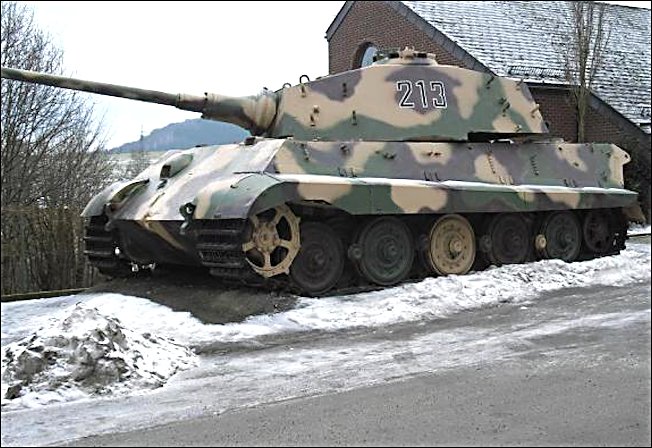
Similar winter condition to those of the Battle of the Bulge December 1944. This King Tiger Tank 213 is in La Gleize, Belgium
King Tiger Tank 213 was disabled defending the Werimont Farm. After the war it was purchased for a bottle of cognac from America Army battlefield salvage units by the local innkeeper's wife Madame Jenny Geenen-Dewez, thus saving it for posterity. It was the platoon command tank of SS-Obersturmführer Dollinger and was part of the Kampfgruppe Peiper. It and another Tiger II tank number 221 and a Panzer IV tank were defending the Werimont Farm high ground on the outskirts of La Gleize.
On 21st December 1944 25 U.S. tanks of Task Force McGeorge and Task Force Lovelady of the 3rd Armored Division attacked La Gleize. As they advanced up the valley the Germans opened fire but scored no direct hits. A lucky American shot hit King Tiger Tank 213's main gun damaging it so that it could not be fired. The tank commander Dollinger received a head injury. The crew abandoned the tank and hid in the cellar of the farm before retreating on foot with the rest of the defeated Kampfgruppe Peiper. The 88 mm gun was restored by welding part of an original Panther tank 75 mm barrel and muzzle brake from one of Skorzeny's disguised tanks left near Malmedy, to the remaining part of the Tiger barrel.
A King Tiger does something really silly at Stavelot
The 3 inch 76.2mm anti-tank M5 guns from the 825th Tank Destroyer Battalion were given the task of slowing down the German advance during the Battle of the Bulge, 16th December 1944, by defending the bridge over the Ambleve River at Stavelot. Sergeant Lou Celentano was one of those gun crews. The first tanks they saw come over the ridge were four Tiger I tanks.
The downhill, bridge approach road was iced up and very slippery. The tigers had problems controlling their tanks on the decent and were not concentrating on the dangers on the other side of the river. The tracks on the front and rear tanks were crippled by the first shots. The middle two tanks were trapped between them. Rapped fire from all the guns in to the side of the Tiger tanks managed to knock all four tanks out. This slowed down the German advance.
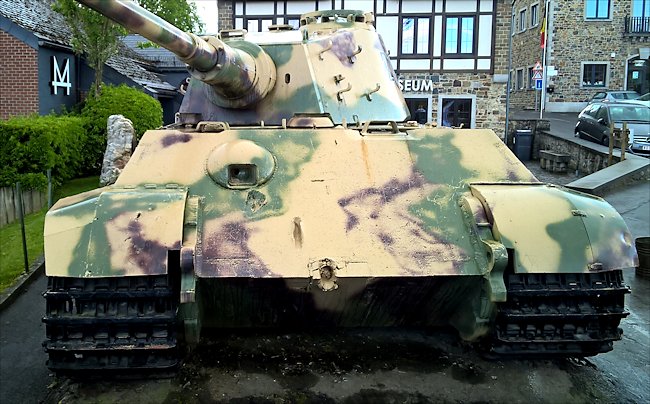
Battle of the Bulge 1944 German King Tiger Tank 213 in La Gleize, Belgium
Sergeant Lou Celentano remembers seeing, "A Tiger Royal swept over the hill and down to the bridge area. He caught Sergeant Armstong’s half-track even before he had a chance to get out of the vehicle. He took a couple of rounds from this Tiger Royal tank and he was completely destroyed. We could hear it coming and we know we were next. There was nothing on earth we could do except try and get out of there. Our guns could not penetrate its armour. We could not move our M5 gun. Repeated firing had drove tail legs deep into the ground. "
"Then the Tiger Royal for some reason wanted to get into a better position to be able to fire on us and he backed up into a huge building. Everything, the whole building came right down on him and we made our escape before that Tiger Royal could do any firing. " The King Tiger tank was knocked out. It could not move.
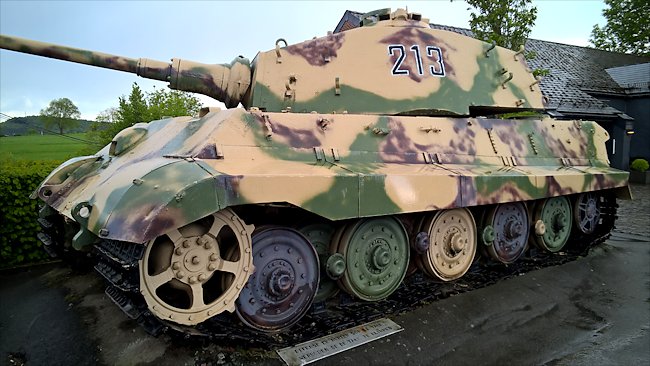
Battle of the Bulge 1944 German King Tiger Tank in La Gleize, Belgium
Where were King Tiger tanks abandoned?
German Heeresgruppe B recorded that it lost 13 King Tiger tanks between the 16th and 31st of December 1944. Two were lost at Stavelot. One being Tiger number 105 that reversed into a building which fell on top of it as mentioned above. The second was King Tiger number 222. It was abandoned at the southern end of the Ambleve bridge whilst supporting Kampfgruppe Sandig on 19 December.
Another two Tiger II tanks were lost in the fields on the advance between the villages of Stavelot and Trois-Point. One of these was Tiger number 003. Another Tiger Royal was abandoned at the village of Petit-Spai by the bridge where it was providing covering fire. A further six Tiger II tanks were abandoned in and around La Gleize.
In the village of Coo the Tiger number 332, was left by the side of the N33 road. The American engineers repaired it. Transported it to the railway station at Spa, where it was put on a train to Antwerp. The Americans then use a crane to put it on the ship bound for the United States. It can be seen at the US Army Ordnance Museum, Fort Lee in Virginia. We do not know where the crew of the 13th tank bailed out
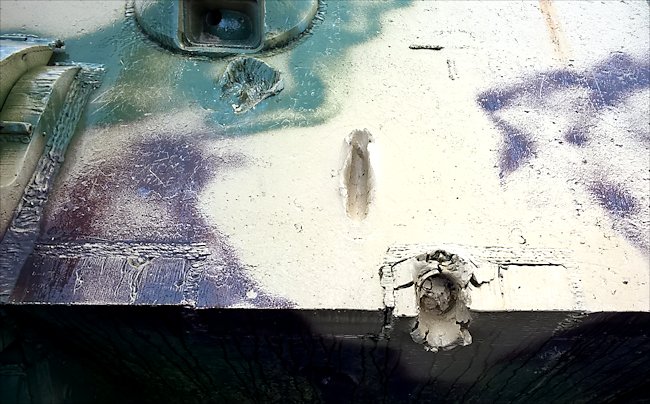
These AP shell hits on this King Tiger Tank's front armour did not penetrate.
What happened to Joachim Peiper's King Tiger Tanks?
The Germans had hoped to get to Antwerp, during the Ardennes is offensive, before the bad weather lifted. Because of all the delays they encountered on the way Battle of the Bulge took much longer than planned. The weather changed and the snow clouds lifted. The skies quickly became filled Allied rocket firing ground attack aircraft.
If the King Tiger had enjoyed the amount of air supremacy and logistical support that the Allied armies had the tank would probably have been a war winner. But lacking any practical air defence, being inside a heavily armoured Tiger II B tank was not without its risks. It was a huge machine and very hard to hide. It provided fighter bomber pilots with a very big easy to see target. Air attack was a frequent cause of destruction for the Royal Tiger tank.
At La Gleize King Tiger commander SS-Standartenführer Joachim Peiper, of the 1st SS Div. Leibstandarte SS Adolf Hitler, could see the hopelessness of the situation. His men were receiving a pounding by American artillery, tanks, infantry and ground attack bomber aircraft. The Americans fired over 58,000 artillery shells into this area. This provides a good picture of the punishment that his men had to endure.
He ordered the tanks, assault guns and half tracks that were still operational, to be destroyed by his own men. They had run out of vital fuel and ammunition. He gave instructions for some of his men stay behind to act as a rearguard, whilst the rest tried to make their way to German lines. He wanted to make the allies believe that they were all still fighting. Peiper took 800 survivors with him.
He left behind and irreplaceable collection of armoured vehicles that would desperately needed by the German army. He had no choice. Their supply route had been cut. The tanks could not go forward or backwards without fuel. Six working Royal Tigers were abandoned, 13 Panthers , 6 Panzer IV tanks, 50 other armoured vehicles, including 45 armoured half tracks.
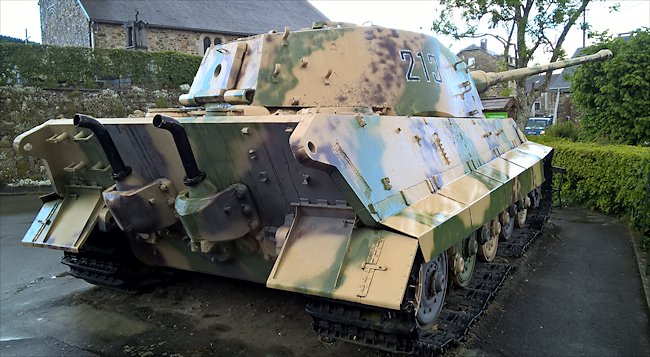
Battle of the Bulge 1944 German King Tiger Tank in La Gleize, Belgium
Misidentification of Tiger II heavy tanks
King Tiger tanks were deployed in the Battle of the Bugle. They were often reported as being encountered by American units in their ‘after action’ reports but this often resulted in misidentification engendered by its largely mythical reputation. Most of the troops had never seen one before. From the front the chassis looks very similar to the Panther tanks.
In reality Tiger II tanks were rarely encountered in battle. Only three heavy tank units took part in the Ardennes offensive of 1944, the ‘Wacht am Rhein’. Most of these heavy panzer units were under strength.
The King Tiger II turret
The Panther tank turret had a dangerous defect that was quickly exploited by allied gun crews. The underneath of the protective gun mantle would deflect any incoming shot downwards onto the weaker armour above the drivers hatch. This was fatal. This design fault was not repeated in both versions of the new King Tiger tank turret.
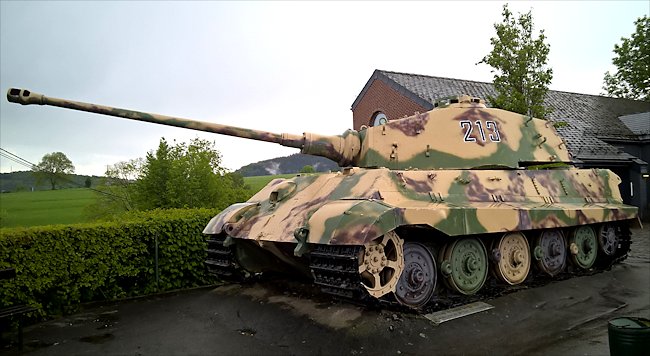
The King Tiger needs a new paint job
Why were King Tiger II tanks not in the front line?
Kampfgruppe Joachim Peiper of 1st SS-Panzerkorps called a briefing before the launch of the Ardennes winter offensive December 1944. He under lined the importance of the operation to his commanders and the need for speed because of the poor levels of fuel and ammunition. He briefed them on the Battle Group Kampfgruppe’s operational role and how its forces were to be organised.
He explained that the two Panzer IV tank companies would be at the front, followed by two panther tank companies. Half-tracks transporting supporting Panzergrenadiers merged in with them. These combat elements were to be followed by artillery and engineer units. Schwere SS-Panzer-Abteilung 501 would bring up the rear with its powerful King Tiger II tanks.
Peiper regarded these bulky slow moving heavy panzers as having little to do with the swift battles he was called upon to conduct. This may be a shock to many WW2 historians who believed that these monster tanks were placed at the forefront of Joachim Peiper Division’s assault.
Battle of the Bulge books

